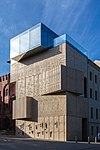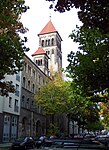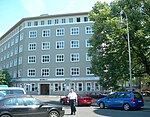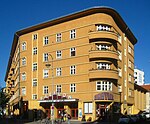Senefelderplatz (Berlin U-Bahn)
Berlin U-Bahn stationsBerlin U-Bahn stubsBerlin railway station stubsBuildings and structures in PankowRailway stations in Germany opened in 1913

Senefelderplatz is a Berlin U-Bahn station located on the line. The station is situated under Senefelderplatz, named after the inventor of the printing technique of lithography, Alois Senefelder. The station was designed by Alfred Grenander and opened in 1913. The grey tiles on the walls are still not covered with advertisements. In November 1943, this station was heavily damaged twice - entrance and the ceiling penetration.
Excerpt from the Wikipedia article Senefelderplatz (Berlin U-Bahn) (License: CC BY-SA 3.0, Authors, Images).Senefelderplatz (Berlin U-Bahn)
Schönhauser Allee, Berlin Prenzlauer Berg
Geographical coordinates (GPS) Address Website Nearby Places Show on map
Geographical coordinates (GPS)
| Latitude | Longitude |
|---|---|
| N 52.532222222222 ° | E 13.4125 ° |
Address
U Senefelderplatz
Schönhauser Allee
10405 Berlin, Prenzlauer Berg
Germany
Open on Google Maps









